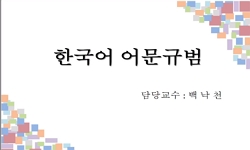본 연구는 표준국어대사전의 <한 걸음 더>를 분석하여 규범 사전으로서의 표준의 성격과 방향을 탐색하는 데에 그 목적이 있다. 표준국어대사전은 한국어 규범 사전�...
http://chineseinput.net/에서 pinyin(병음)방식으로 중국어를 변환할 수 있습니다.
변환된 중국어를 복사하여 사용하시면 됩니다.
- 中文 을 입력하시려면 zhongwen을 입력하시고 space를누르시면됩니다.
- 北京 을 입력하시려면 beijing을 입력하시고 space를 누르시면 됩니다.

표준국어대사전 개편과 규범 정보 = The Revision of the Standard Korean Dictionary and Normative Information
한글로보기부가정보
국문 초록 (Abstract)
본 연구는 표준국어대사전의 <한 걸음 더>를 분석하여 규범 사전으로서의 표준의 성격과 방향을 탐색하는 데에 그 목적이 있다. 표준국어대사전은 한국어 규범 사전으로서, 언어 생활의 규범 역할을 한다. 어문 규범이나 어문 규범의 해설만으로는 전달할 수 없는 규범의 상세한 적용 실례는 규범 사전에서 확인해야 한다. 그러한 면에서 표준국어대사전은 규범에서 제시한 것 이외의 원칙을 제시하거나 관습적으로 굳어진 예외를 수록하고 해설하는 역할도 수행하고 있다고 할 수 있다.
현재의 <한 걸음 더>, 구 <규범 정보>는 사전 표제어에 적용된 규범을 보충하여 해설해 주는 부가 정보이다. 본 연구에서는 <규범 정보>의 유형을 총 8개로 나누어 보았는데, 순서대로 표제어의 표준어 여부에 대한 해설, 표제어의 표기에 대한 해설, 표제어의 표준 발음에 대한 해설, 표제어의 활용 정보에 대한 해설, 표제어의 용례/용법에 대한 해설, 표제어의 의미(뜻풀이)에 대한 해설, 표제어의 화용 정보에 대한 해설, 표제어 간의 형태/의미의 차이에 대한 해설이 있었다. 처음의 두 유형이 과반수 이상을 차지하고 있으나, 어문 규정에서 제시하지 않은 것들까지도 기술의 대상에 포함하고 있는 것을 확인할 수 있었다.
즉, <규범 정보>의 검토를 통해 표준국어대사전이 목표하고 있는 규범성의 범위가 더 넓어지고 있다는 점과 규범성이 점점 더 강화되고 있다는 것을 알 수 있다. 그러나 표준국어대사전의 규범성이 강화되는 것이 과연 바람직한지, 앞으로 <규범 정보>의 기술 확대가 긴요할 것인지에 대한 검토가 필요할 것이며, <규범 정보>의 역할은 실질적으로 표준국어대사전의 내적 체계를 보충하고 어문 규범의 실질적인 문제들을 보완하는 것이 바람직하다고 주장하였다.
다국어 초록 (Multilingual Abstract)
This study aims to analyze the “One Step Further” section of the Standard Korean Dictionary in order to explore the nature and direction of the “Standard” as a normative dictionary. The Standard Korean Dictionary serves as a normative dictiona...
This study aims to analyze the “One Step Further” section of the Standard Korean Dictionary in order to explore the nature and direction of the “Standard” as a normative dictionary. The Standard Korean Dictionary serves as a normative dictionary for Korean, playing a normative role in language use. Detailed examples of norm application that cannot be conveyed solely through linguistic norms or their explanations must be confirmed in normative dictionaries. In this regard, the Standard Korean Dictionary not only presents principles beyond those stated in norms but also includes and explains exceptions that have conventionally solidified.
The current “One Step Further,” formerly known as “Normative Information,” supplements and explains the norms applied to dictionary entries. In this study, the types of “One Step Further” were divided into 8 categories: explanations on whether the entry is standard Korean, explanations on the spelling of the entry, explanations on the standard pronunciation of the entry, explanations on usage information of the entry, explanations on examples/usages of the entry, explanations on the meaning (definition) of the entry, explanations on pragmatic information of the entry, and explanations on the differences in form/meaning between entries. The first two types comprise the majority, but it was noted that even aspects not specified in linguistic norms were included in the scope of description.
In conclusion, through the review of “One Step Further,” it can be observed that the scope of normativity pursued by the Standard Korean Dictionary is expanding, and normativity is increasingly being strengthened. It will be necessary to evaluate whether the reinforcement of normativity in the Standard Korean Dictionary is indeed desirable and whether the expansion of the description in “One Step Further” will be necessary in the future to complement practical issues in linguistic norms.
동일학술지(권/호) 다른 논문
-
재일(在日) 조선학교 국어 교과서 특성 연구 -6차 개편(2003년) 중급학교 교과서를 중심으로-
- 반교어문학회
- 김한근
- 2024
- KCI등재
-
- 반교어문학회
- 박진영
- 2024
- KCI등재
-
‘고유명사’ 표제어 정비에 대한 표준국어대사전 과 우리말샘 의 관계
- 반교어문학회
- 이성우
- 2024
- KCI등재
-
- 반교어문학회
- 염희경
- 2024
- KCI등재




 KISS
KISS




